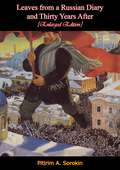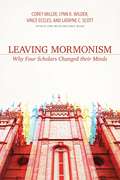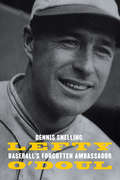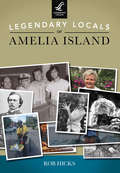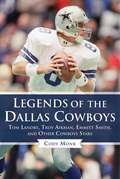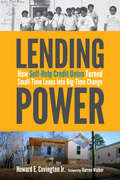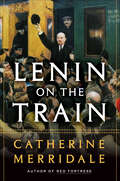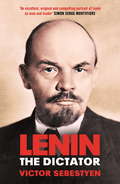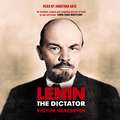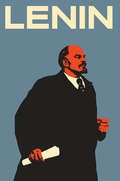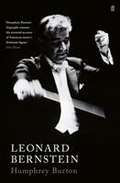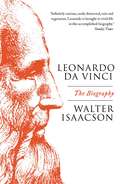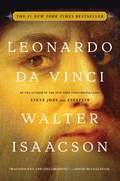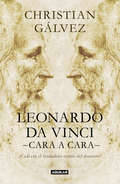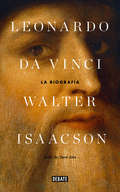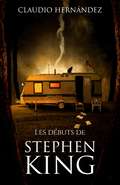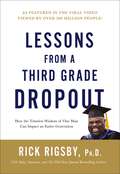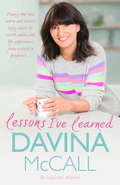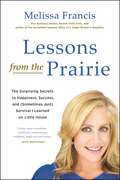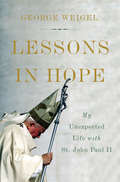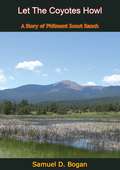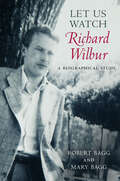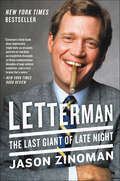- Table View
- List View
Leaves from a Russian Diary—and Thirty Years After [Enlarged Edition]
by Pitirim A. SorokinThe reminiscences of a fiercely anti-Communist Petrograd professor, Pitirim A. Sorokin—from the February Revolution right through to his departure from Russia in September 1922.This is the enlarged edition published almost 30 years after the first 1924 publication and contains the additional section, “Thirty Years After,” in which the author describes how the Revolution that has since come of age has turned out to be simultaneously “a gigantic success and a colossal failure.”A fascinating read.
Leaving Mormonism: Why Four Scholars Changed Their Minds
by Latayne Scott Corey Miller Lynn Wilder Vince Eccles"'As former Mormons turned evangelical Christians, all of whom are accomplished scholars, the four contributors to this volume provide a unique and authoritative corrective. Each shares his or her story of growing up in the Mormon Church, and how biblical, theological, moral, or scientific issues forced them to eventually leave Mormonism. The writers draw on the expertise of their respective academic fields to show how Mormon teachings and practice fall short biblically and rationally. "'They also address common objections raised by former Mormons who have lost faith altogether and have embraced atheism or agnosticism--especially under the influence of 'new atheists' like Richard Dawkins and Christopher Hitchens.'" Even for non-Mormons or for non-ex-Mormons, this book provides powerful Christian apologetics which people need to hear and understand in this secular culture in which we live especially at the college and university level. Besides giving ex-Mormons a Christian alternative, another reason that the writers wrote this book was to give Christian students the understanding and tools necessary to help them defend their faith in these secular environments. Also, often people have doubts about their faith and this book will help them deal with their doubts effectively. At the end of each entry, the authors provide extensive notes, which not only substantiate their facts and thinking, but provide the reader with additional resources.
Lefty O'Doul: Baseball's Forgotten Ambassador
by Dennis SnellingFrom San Francisco to the Ginza in Tokyo, Lefty O’Doul relates the untold story of one of baseball’s greatest hitters, most colorful characters, and the unofficial father of professional baseball in Japan. Lefty O’Doul (1897–1969) began his career on the sandlots of San Francisco and was drafted by the Yankees as a pitcher. Although an arm injury and his refusal to give up the mound clouded his first four years, he converted into an outfielder. After four Minor League seasons he returned to the Major Leagues to become one of the game’s most prolific power hitters, retiring with the fourth-highest lifetime batting average in Major League history. A self-taught “scientific” hitter, O’Doul then became the game’s preeminent hitting instructor, counting Joe DiMaggio and Ted Williams as his top disciples. In 1931 O’Doul traveled to Japan with an All-Star team and later convinced Babe Ruth to headline a 1934 tour. By helping to establish the professional game in Japan, he paved the way for Hideo Nomo, Ichiro Suzuki, and Hideki Matsui to play in the American Major Leagues. O’Doul’s finest moment came in 1949, when General Douglas MacArthur asked him to bring a baseball team to Japan, a tour that MacArthur later praised as one of the greatest diplomatic efforts in U.S. history. O’Doul became one of the most successful managers in the Pacific Coast League and was instrumental in spreading baseball’s growth and popularity in Japan. He is still beloved in Japan, where in 2002 he was inducted into the Japanese Baseball Hall of Fame.
Legendary Locals of Amelia Island (Legendary Locals)
by Rob HicksAmelia Island has been host to remarkable people throughout its 500-year history. These people are responsible for giving Amelia the distinction as the only place in the United States to have seen eight different flags. A new railroad followed the Civil War and brought those who sought to take advantage of the burgeoning shipping center. As opportunities waned, the island became a sleepy, blue collar community supported by the local paper mills. Prior to civil rights legislation desegregating the South, Fernandina’s American Beach flourished as an African American coastal community. Meanwhile, local visionaries oversaw tight-knit communities and set the stage for the large resorts that came to the island’s south end in the 1970s. Today, Amelia Island is a national tourist destination and home to a diverse of community of longtime residents and newcomers, both with remarkable talents and interesting stories to tell.
Legends of the Dallas Cowboys: Tom Landry, Troy Aikman, Emmitt Smith, and Other Cowboys Stars (Legends of the Team)
by Cody MonkFive Super Bowl titles, fifteen Hall of Famers, and a litany of legendary players, characters, and games later, the Dallas Cowboys franchise has cemented itself among the most successful in all of sports and, with a fan base that extends all over the world, among the most well known.Legends of the Dallas Cowboys takes an in-depth look at some of the legends who have shaped the Cowboys’ identity, beginning with Tom Landry, the man who was hired before Murchison had been awarded a team and who is still the franchise’s enduring image. Also included is Tex Schramm, under whom the Cowboys had twentystraight winning seasons and who is considered the most forward-thinking NFL executive ever, as well as Randy White, Ed “Too Tall” Jones, Bob Lilly, Lee Roy Jordan, Mel Renfro, and more. Also included are innovators such as Bob Hayes, who forced the creation of the zone defense, and Michael Irvin and Thomas “Hollywood” Henderson, who forced the creation of behavioral clauses in contracts. Each of the legends played his own unique role in shaping the lore of one of sports’ greatest franchises, a franchise that began humbly on a winter day in Miami and is now a model of success.
Lending Power: How Self-Help Credit Union Turned Small-Time Loans into Big-Time Change
by Howard E. Covington Jr. Jr.Established by Martin Eakes and Bonnie Wright in North Carolina in 1980, the nonprofit Center for Community Self-Help has grown from an innovative financial institution dedicated to civil rights into the nation's largest home lender to low- and moderate-income borrowers. Self-Help's first capital campaign—a bake sale that raised a meager seventy-seven dollars for a credit union—may not have done much to fulfill the organization's early goals of promoting worker-owned businesses, but it was a crucial first step toward wielding inclusive lending as a weapon for economic justice. In Lending Power journalist and historian Howard E. Covington Jr. narrates the compelling story of Self-Help's founders and coworkers as they built a progressive and community-oriented financial institution. First established to assist workers displaced by closed furniture and textile mills, Self-Help created a credit union that expanded into providing home loans for those on the margins of the financial market, especially people of color and single mothers. Using its own lending record, Self-Help convinced commercial banks to follow suit, extending its influence well beyond North Carolina. In 1999 its efforts led to the first state law against predatory lending. A decade later, as the Great Recession ravaged the nation's economy, its legislative victories helped influence the Dodd-Frank Wall Street Reform and Consumer Protection Act and the formation of the Consumer Financial Protection Bureau. Self-Help also created a federally chartered credit union to expand to California and later to Illinois and Florida, where it assisted ailing community-based credit unions and financial institutions. Throughout its history, Self-Help has never wavered from its mission to use Dr. Martin Luther King Jr.'s vision of justice to extend economic opportunity to the nation's unbanked and underserved citizens. With nearly two billion dollars in assets, Self-Help also shows that such a model for nonprofits can be financially successful while serving the greater good. At a time when calls for economic justice are growing ever louder, Lending Power shows how hard-working and dedicated people can help improve their communities.
Lenin on the Train
by Catherine MerridaleOne of The Economist's Best Books of the YearA gripping, meticulously researched account of Lenin’s fateful 1917 rail journey from Zurich to Petrograd, where he ignited the Russian Revolution and forever changed the worldIn April 1917, as the Russian Tsar Nicholas II’s abdication sent shockwaves across war-torn Europe, the future leader of the Bolshevik revolution Vladimir Lenin was far away, exiled in Zurich. When the news reached him, Lenin immediately resolved to return to Petrograd and lead the revolt. But to get there, he would have to cross Germany, which meant accepting help from the deadliest of Russia’s adversaries. Millions of Russians at home were suffering as a result of German aggression, and to accept German aid—or even safe passage—would be to betray his homeland. Germany, for its part, saw an opportunity to further destabilize Russia by allowing Lenin and his small group of revolutionaries to return. Now, in Lenin on the Train, drawing on a dazzling array of sources and never-before-seen archival material, renowned historian Catherine Merridale provides a riveting, nuanced account of this enormously consequential journey—the train ride that changed the world—as well as the underground conspiracy and subterfuge that went into making it happen. Writing with the same insight and formidable intelligence that distinguished her earlier works, she brings to life a world of counter-espionage and intrigue, wartime desperation, illicit finance, and misguided utopianism. When Lenin arrived in Petrograd’s now-famous Finland Station, he delivered an explosive address to the impassioned crowds. Simple and extreme, the text of this speech has been compared to such momentous documents as Constantine’s edict of Milan and Martin Luther’s ninety-five theses. It was the moment when the Russian revolution became Soviet, the genesis of a system of tyranny and faith that changed the course of Russia’s history forever and transformed the international political climate.
Lenin the Dictator
by Victor Sebestyen'A fresh, powerful portrait of Lenin' Anne Applebaum, author of Red Famine'Richly readable ... An enthralling but appalling story' Francis Wheen, author of Karl MarxThe cold, one-dimensional figure of Lenin the political fanatic is only a partial truth. Drawing on extensive material that has only recently become available, Sebestyen's gripping biography casts an intriguing new light on the character behind the politics.In reality, Lenin was a man who loved nature as much as he loved making revolution, and his closest relationships were with women. He built a state based on terror. But he was a highly emotional man given to furious rages and deep passions. While never ignoring the politics, Sebestyen examines Lenin's inner life, his relationship with his wife and his long love affair with Inessa Armand, the most romantic and beguiling of Bolsheviks. These two women were as significant as the men - Stalin or Trotsky - who created the world's first Communist state with him.
Lenin the Dictator
by Victor SebestyenVictor Sebestyen's intimate biography is the first major work in English for nearly two decades on one of the most significant figures of the twentieth century. In Russia to this day Lenin inspires adulation. Everywhere, he continues to fascinate as a man who made history, and who created a new kind of state that would later be imitated by nearly half the countries in the world.Lenin believed that the 'the political is the personal', and while in no way ignoring his political life, Sebestyen's focus will be on Lenin the man - a man who loved nature almost as much as he loved making revolution, and whose closest ties and friendships were with women. The long-suppressed story of his ménage a trois with his wife, Nadezhda Krupskaya, and his mistress and comrade, Inessa Armand, reveals a different character to the coldly one-dimensional figure of legend.Told through the prism of Lenin's key relationships, Sebestyen's lively biography casts a new light the Russian Revolution, one of the great turning points of modern history.Read by Jonathan Aris(p) 2017 Orion Publishing Group Ltd
Lenin the Dictator: The Man, The Dictator, And The Master Of Terror
by Victor Sebestyen'A fresh, powerful portrait of Lenin' Anne Applebaum, author of Red Famine'Richly readable ... An enthralling but appalling story' Francis Wheen, author of Karl MarxThe cold, one-dimensional figure of Lenin the political fanatic is only a partial truth. Drawing on extensive material that has only recently become available, Sebestyen's gripping biography casts an intriguing new light on the character behind the politics.In reality, Lenin was a man who loved nature as much as he loved making revolution, and his closest relationships were with women. He built a state based on terror. But he was a highly emotional man given to furious rages and deep passions. While never ignoring the politics, Sebestyen examines Lenin's inner life, his relationship with his wife and his long love affair with Inessa Armand, the most romantic and beguiling of Bolsheviks. These two women were as significant as the men - Stalin or Trotsky - who created the world's first Communist state with him.
Lenin: The Man, the Dictator, and the Master of Terror
by Victor SebestyenVictor Sebestyen's riveting biography of Vladimir Ilyich Lenin—the first major biography in English in nearly two decades—is not only a political examination of one of the most important historical figures of the twentieth century but also a fascinating portrait of Lenin the man.Brought up in comfort and with a passion for hunting and fishing, chess, and the English classics, Lenin was radicalized after the execution of his brother in 1887. Sebestyen traces the story from Lenin's early years to his long exile in Europe and return to Petrograd in 1917 to lead the first Communist revolution in history. Uniquely, Sebestyen has discovered that throughout Lenin's life his closest relationships were with his mother, his sisters, his wife, and his mistress. The long-suppressed story told here of the love triangle that Lenin had with his wife, Nadezhda Krupskaya, and his beautiful, married mistress and comrade, Inessa Armand, reveals a more complicated character than that of the coldly one-dimensional leader of the Bolshevik Revolution.With Lenin's personal papers and those of other leading political figures now available, Sebestyen gives is new details that bring to life the dramatic and gripping story of how Lenin seized power in a coup and ran his revolutionary state. The product of a violent, tyrannical, and corrupt Russia, he chillingly authorized the deaths of thousands of people and created a system based on the idea that political terror against opponents was justified for a greater ideal. An old comrade what had once admired him said that Lenin "desired the good . . . but created evil." This included his invention of Stalin, who would take Lenin's system of the gulag and the secret police to horrifying new heights.In Lenin, Victor Sebestyen has written a brilliant portrait of this dictator as a complex and ruthless figure, and he also brings to light important new revelations about the Russian Revolution, a pivotal point in modern history.(With 16 pages of black-and-white photographs)
Leonard Bernstein
by Humphrey BurtonA biography of Leonard Bernstein, 1918-1990, one of the greatest conductors of the 20th century, by a friend and professional colleague. It covers his personal and family life, including his bisexuality, his conducting, composing and teaching. Bernstein was an early proponent of the music of Gustav Mahler and of American composers. His many recordings and his Young People's Concert lectures are still revered today. The original edition appeared in 1994. This edition features a new Introduction from 2017 which analyzes some of the biographical works that have appeared subsequently by other authors.
Leonardo Da Vinci: Cong Fan Ren Dao Tian Cai De Chuang Zao Li Mi Ma = Leonardo Da Vinci
by Walter Isaacson'To read this magnificent biography of Leonardo da Vinci is to take a tour through the life and works of one of the most extraordinary human beings of all time in the company of the most engaging, informed, and insightful guide imaginable. Walter Isaacson is at once a true scholar and a spellbinding writer. And what a wealth of lessons there are to be learned in these pages.' David McCullough Based on thousands of pages from Leonardo&’s astonishing notebooks and new discoveries about his life and work, Walter Isaacson weaves a narrative that connects his art to his science. He shows how Leonardo&’s genius was based on skills we can improve in ourselves, such as passionate curiosity, careful observation, and an imagination so playful that it flirted with fantasy. He produced the two most famous paintings in history, The Last Supper and the Mona Lisa. But in his own mind, he was just as much a man of science and technology. With a passion that sometimes became obsessive, he pursued innovative studies of anatomy, fossils, birds, the heart, flying machines, botany, geology, and weaponry. His ability to stand at the crossroads of the humanities and the sciences, made iconic by his drawing of Vitruvian Man, made him history&’s most creative genius. His creativity, like that of other great innovators, came from having wide-ranging passions. He peeled flesh off the faces of cadavers, drew the muscles that move the lips, and then painted history&’s most memorable smile. He explored the math of optics, showed how light rays strike the cornea, and produced illusions of changing perspectives in The Last Supper. Isaacson also describes how Leonardo&’s lifelong enthusiasm for staging theatrical productions informed his paintings and inventions. Leonardo&’s delight at combining diverse passions remains the ultimate recipe for creativity. So, too, does his ease at being a bit of a misfit: illegitimate, gay, vegetarian, left-handed, easily distracted, and at times heretical. His life should remind us of the importance of instilling, both in ourselves and our children, not just received knowledge but a willingness to question it—to be imaginative and, like talented misfits and rebels in any era, to think different.
Leonardo da Vinci
by Walter Isaacson<P>He was history’s most creative genius. What secrets can he teach us? The author of the acclaimed bestsellers Steve Jobs, Einstein, and Benjamin Franklin brings Leonardo da Vinci to life in this exciting new biography. <P>Based on thousands of pages from Leonardo’s astonishing notebooks and new discoveries about his life and work, Walter Isaacson weaves a narrative that connects his art to his science. He shows how Leonardo’s genius was based on skills we can improve in ourselves, such as passionate curiosity, careful observation, and an imagination so playful that it flirted with fantasy. He produced the two most famous paintings in history, The Last Supper and the Mona Lisa. But in his own mind, he was just as much a man of science and technology. <P>With a passion that sometimes became obsessive, he pursued innovative studies of anatomy, fossils, birds, the heart, flying machines, botany, geology, and weaponry. His ability to stand at the crossroads of the humanities and the sciences, made iconic by his drawing of Vitruvian Man, made him history’s most creative genius. His creativity, like that of other great innovators, came from having wide-ranging passions. He peeled flesh off the faces of cadavers, drew the muscles that move the lips, and then painted history’s most memorable smile. He explored the math of optics, showed how light rays strike the cornea, and produced illusions of changing perspectives in The Last Supper. <P>Isaacson also describes how Leonardo’s lifelong enthusiasm for staging theatrical productions informed his paintings and inventions. Leonardo’s delight at combining diverse passions remains the ultimate recipe for creativity. So, too, does his ease at being a bit of a misfit: illegitimate, gay, vegetarian, left-handed, easily distracted, and at times heretical. His life should remind us of the importance of instilling, both in ourselves and our children, not just received knowledge but a willingness to question it—to be imaginative and, like talented misfits and rebels in any era, to think different. <P><b>A New York Times Bestseller</b>
Leonardo da Vinci -cara a cara-: ¿Cuál era el verdadero rostro del maestro?
by Christian GálvezTras el éxito de sus novelas de la serie «Crónicas del Renacimiento» Matar a Leonardo da Vinci y Rezar por Miguel Ángel, Christian Gálvez presenta en esta ocasión un fascinante análisis ilustrado de todas las teorías existentes sobre la imagen de Leonardo da Vinci. «Muchos de los manuscritos sobre anatomía humana están en posesión de Francesco Melzi, un gentilhombre de Milán que era un hombre bello en el tiempo en que Leonardo vivía y al que le profesaba un gran cariño. Francesco aprecia y conserva estos trabajos como reliquias de Leonardo, junto con el retrato de este artista en su feliz recuerdo.» Con estas palabras Giorgio Vasari, uno de los primeros historiadores de arte y autor de las biografías de los artistas italianos durante el Renacimiento, asegura que existe un retrato de Leonardo da Vinci que Francesco Melzi, alumno, secretario y albacea del artista florentino, guardó al morir el maestro. Por lo tanto tenemos una referencia histórica real de dicha imagen. ¿A qué retrato se refería Vasari? ¿Al supuesto autorretrato que guarda la Biblioteca Real de Turín y que mundialmente se reconoce como tal?, ¿o por el contrario al retrato que realizó Francesco Melzi mientras su maestro seguía con vida? ¿Son compatibles ambos retratos? ¿Coinciden esos rostros con el resto del imaginario de Leonardo da Vinci, tales como el de El hombre de Vitruvio de Venecia o los de La última cena de Milán? ¿Quién es el hombre representado en la Tavola Lucana? A través de estas páginas, prologadas por el prestigioso historiador Ross King, analizaremos todas las teorías que eruditos, historiadores y expertos en arte han elaborado en torno a la imagen del maestro florentino con un único objetivo: encontrar el verdadero rostro del polímata más conocido de la historia de la humanidad: Leonardo da Vinci.
Leonardo da Vinci: La biografía
by Walter IsaacsonEl aclamado autor de los best sellers Steve Jobs y Einstein nos vuelve a cautivar con la vida del genio más creativo de la historia en esta fascinante biografía. Basándose en las miles de páginas de los cuadernos manuscritos de Leonardo y nuevos descubrimientos sobre su vida y su obra, Walter Isaacson teje una narración que conecta el arte de Da Vinci con sus investigaciones científicas, y nos muestra cómo el genio del hombre más visionario de la historia nació de habilidades que todos poseemos y podemos estimular, tales como la curiosidad incansable, la observación cuidadosa y la imaginación juguetona. Su creatividad, como la de todo gran innovador, resultó de la intersección entre la tecnología y las humanidades. Despellejó y estudió el rostro de numerosos cadáveres, dibujó los músculos que configuran el movimiento de los labios y pintó la sonrisa más enigmática de la historia, la de la Mona Lisa. Exploró las leyes de la óptica, demostró como la luz incidía en la córnea y logró producir esa ilusión de profundidad en la Última cena. La habilidad de Leonardo da Vinci para combinar arte y ciencia -esplendorosamente representada en el Hombre de Vitruvio- continúa siendo la regla de oro de la innovación. La apasionante vida de este gran hombre debe recordarnos la importancia de inculcar el conocimiento, pero sobre todo la voluntad contagiosa de cuestionarlo: ser imaginativos y pensar de manera diferente.
Leonardo da Vinci: La biografía
by Walter IsaacsonEl aclamado autor de los best sellers Steve Jobs y Einstein nos vuelve a cautivar con la vida del genio más creativo de la historia en esta fascinante biografía. Basándose en las miles de páginas de los cuadernos manuscritos de Leonardo y nuevos descubrimientos sobre su vida y su obra, Walter Isaacson teje una narración que conecta el arte de Da Vinci con sus investigaciones científicas, y nos muestra cómo el genio del hombre más visionario de la historia nació de habilidades que todos poseemos y podemos estimular, tales como la curiosidad incansable, la observación cuidadosa y la imaginación juguetona. Su creatividad, como la de todo gran innovador, resultó de la intersección entre la tecnología y las humanidades. Despellejó y estudió el rostro de numerosos cadáveres, dibujó los músculos que configuran el movimiento de los labios y pintó la sonrisa más enigmática de la historia, la de la Mona Lisa. Exploró las leyes de la óptica, demostró como la luz incidía en la córnea y logró producir esa ilusión de profundidad en la Última cena. La habilidad de Leonardo da Vinci para combinar arte y ciencia -esplendorosamente representada en el Hombre de Vitruvio- continúa siendo la regla de oro de la innovación. La apasionante vida de este gran hombre debe recordarnos la importancia de inculcar el conocimiento, pero sobre todo la voluntad contagiosa de cuestionarlo: ser imaginativos y pensar de manera diferente.
Les débuts de Stephen King
by June Silinski Claudio HernándezL’écrivain du Maine, comme beaucoup l’appellent, était prédestiné à devenir le meilleur écrivain d’horreur de l’Histoire. C’est ce que nous démontre sa carrière littéraire. En dépit des centaines de refus qu’il dut essuyer à l’époque de ses premières nouvelles et de ses premiers romans, le destin était écrit : le clou qui tenait les lettres de refus finit par tomber. Stephen King commença à écrire à l’âge de huit ans et il publierait ses premières nouvelles dès le début. Les enfants de l’école le lisaient. Parvenir à la publication de Carrie, l’ouvrage avec lequel sa carrière professionnelle débuta, n’eut rien de facile. Avant cela, il survivait à l’aide d’emplois nombreux et variés ainsi que les chèques qu’il recevait pour ses nouvelles. La mort et la peur furent toujours à ses côtés, depuis l’époque où il creusait des tombes dans le cimetière local à l’adolescence, son premier travail rémunéré. Sa ténacité et sa constance lui permirent d’être reconnu comme le « Roi », un hommage à son nom de famille « King », qui n’aurait pas pu mieux tomber. Dans cet ouvrage, vous découvrirez ses débuts : ses arrière-grands-parents, ses grands-parents, ses parents, la pauvreté, la caisse des manuscrits de son père, ses premiers contes, l’époque du lycée dont il ne souhaite pas se souvenir, l’université, ses premiers romans, son travail en tant que professeur d’anglais, son alter ego, ses problèmes… Et finalement, son succès de masse. Il s’agit d’une étude de la première étape, la plus pure, de Stephen King, celle qui nous marqua tous et qui ferait de lui le roi de l’horreur. Un jour, son doigt se posa au hasard sur une carte des États-Unis et atterrit dans le Colorado, sur l’hôtel Stanley. Et le destin suivit son cours. Vous devinez de quelle histoire il s’agit ?
Lessons From a Third Grade Dropout: How The Timeless Wisdom Of One Man Can Impact An Entire Generation
by Rick Rigsby* USA Today and Wall Street Journal best seller* Be inspired by the book behind the graduation speech by Dr. Rick Rigsby – now with 200+ million views on Facebook and YouTubeReacquaint yourself with the wisdom of a generation gone by.We live in an era of low expectations. In fact, we tend to celebrate low expectations. The way in which we choose to live and work today is a far cry from the purposeful living of our parents.Have we reached the point in our society where it is more important to look good rather than be good? Has the pride in doing good work been replaced by self-entitlement, perfect offices, and slick suits?This book reacquaints readers with the wisdom—the common sense that was practiced simply and unwittingly by those who represent a generation gone by:A generation that worked hard without complaining.A generation that did whatever was necessary to support their families.A generation that took pride in doing a good job.A generation that had high expectations for themselves and the others they were responsible for.One such member of this generation was a third-grade dropout, a man who never hid behind any excuse. A man who never allowed his problems or lack of a formal education to determine his present or affect his future. A man who realized that destiny was a choice and not a chance.This book communicates lessons from that man’s life—the kind of wisdom that is rare in society today. It’s the kind of wisdom that will help you be a better person, a greater leader, a more effective worker.That man was Rick Rigsby’s father, and this book contains his impactful, far-reaching story—of how a life can be enhanced, of how a corporate culture can be changed, of how a family can be united—by living the simple lessons of a third-grade dropout.
Lessons I've Learned
by Davina MccallWith her trademark humour, warmth and honesty, Davina McCall shares her life experiences."I am a work in progress. There are times when I feel in control and like I know what I'm doing . . . and there are times (quite a few) (actually lots) when I've got no idea what's going on, where to turn, what to do, how to behave, and those are the times I've sought help!I have been helped by some extraordinary people. I've been supported and counselled through my recovery from drugs and alcohol. I've been hypnotised to get me through my ultimate fears. I've read a squibillion (that's a lot) of fantastic self-help books and I have shared and shared with the greatest girlfriends and family of all time. These nuggets of wisdom have, at times, literally kept me going, so I thought I'd pay it forward and share them with you . . ."In this long-awaited book, Davina McCall shares the tips and wisdoms learned on her 'work-in-progess' journey through life.Warm, engaging, honest and generous, this book will make you laugh and cry in equal measure. Lessons I've Learned is the closest thing to a Davina hug and we all need one of those . . .
Lessons from the Prairie (Sometimes Just) Survival I Learned on America's Favorite Show: The Surprising Secrets To Happiness, Success, And (sometimes Just) Survival I Learned On America's Favorite Show
by Melissa FrancisMelissa Francis was only eight years old when she won the role of a lifetime: playing Cassandra Cooper Ingalls on the world's most famous prime-time soap opera, Little House on the Prairie.Now in Lessons from the Prairie, she shares behind-the-scenes stories from the set, and lessons learned from the show's dynamic creator, Michael Landon, that have echoed throughout Melissa's adult life. With novel insights on hard work, making mistakes, and even spirituality, Francis shares inspirational and practical life lessons that will appeal both to her current TV fans, and fans of one of the most adored TV shows of all time.
Lessons in Hope: My Unexpected Life With St. John Paul Ii
by George WeigelA preeminent authority on the Catholic Church and papal biographer describes what he learned from chronicling the life of Pope John Paul IIIn Lessons in Hope, George Weigel tells the story of his unique friendship with St. John Paul II. As Weigel learns the pope "from inside," he also offers a firsthand account of the tumult of post-Vatican II Catholicism and the Cold War's endgame, introducing readers to the heroes who brought down European communism. Later, he shows us the aging pope grappling with the post-9/11 world order and teaching new lessons in dignity through his own suffering.A deeply humane portrait of an eminent scholar learning a saint, Lessons in Hope is essential reading for anyone seeking a fuller understanding of a world-changing pope.
Let The Coyotes Howl: A Story of Philmont Scout Ranch
by Samuel D. BoganFirst published in 1946, “this day-by-day narrative of events on a scout expedition will interest every ex-scout by reviving memories of his own experiences and his fondest daydreams. The contemporary scout will find it fascinating as proof that his own hopes are not beyond realization. That the members of this party chose an archaeological objective is not vital, for had they been interested in a survey of insect life, small rodents, reptiles, birds, or even wild plants, their story would have been equally interesting. In fact, many other objectives could be chosen, all equally promising, such as making a topographical map, a geological survey, or a study of stream and wind erosion. Finally, a historical program could be devised, such as following the trail of De Soto, part of the trail of Lewis and Clark, or the path of prairie schooners along the Old Platte Trail.”—Samuel D. Bogan
Let Us Watch Richard Wilbur: A Biographical Study
by Robert Bagg Mary BaggPulitzer Prize–winning poet Richard Wilbur (b. 1921) is part of a notable literary cohort, American poets who came to prominence in the mid-twentieth century. Wilbur's verse is esteemed for its fluency, wit, and optimism; his ingeniously rhymed translations of French drama by Molière, Racine, and Corneille remain the most often staged in the English-speaking world; his essays possess a scope and acumen equal to the era's best criticism. This biography examines the philosophical and visionary depth of his world-renowned poetry and traces achievements spanning seventy years, from political editorials about World War II to war poems written during his service to his theatrical career, including a contentious collaboration with Leonard Bernstein and Lillian Hellman. Wilbur's life has been mistakenly seen as blessed, lacking the drama of his troubled contemporaries. Let Us Watch Richard Wilbur corrects that view and explores how Wilbur's perceived "normality" both enhanced and limited his achievement. The authors augment the life story with details gleaned from access to his unpublished journals, family archives, candid interviews they conducted with Wilbur and his wife, Charlee, and his correspondence with Robert Lowell, Elizabeth Bishop, John Berryman, John Malcolm Brinnin, James Merrill, and others.
Letterman: The Last Giant of Late Night
by Jason ZinomanNew York Times comedy critic Jason Zinoman delivers the definitive story of the life and artistic legacy of David Letterman, the greatest television talk show host of all time and the signature comedic voice of a generation.In a career spanning more than thirty years, David Letterman redefined the modern talk show with an ironic comic style that transcended traditional television. While he remains one of the most famous stars in America, he is a remote, even reclusive, figure whose career is widely misunderstood. In Letterman, Jason Zinoman, the first comedy critic in the history of the New York Times, mixes groundbreaking reporting with unprecedented access and probing critical analysis to explain the unique entertainer’s titanic legacy. Moving from his early days in Indiana to his retirement, Zinoman goes behind the scenes of Letterman’s television career to illuminate the origins of his revolutionary comedy, its overlooked influences, and how his work intersects with and reveals his famously eccentric personality. Zinoman argues that Letterman had three great artistic periods, each distinct and part of his evolution. As he examines key broadcasting moments—"Stupid Pet Tricks" and other captivating segments that defined Late Night with David Letterman—he illuminates Letterman’s relationship to his writers, and in particular, the show’s co-creator, Merrill Markoe, with whom Letterman shared a long professional and personal connection.To understand popular culture today, it’s necessary to understand David Letterman. With this revealing biography, Zinoman offers a perceptive analysis of the man and the artist whose ironic voice and caustic meta-humor was critical to an entire generation of comedians and viewers—and whose singular style ushered in new tropes that have become clichés in comedy today.
